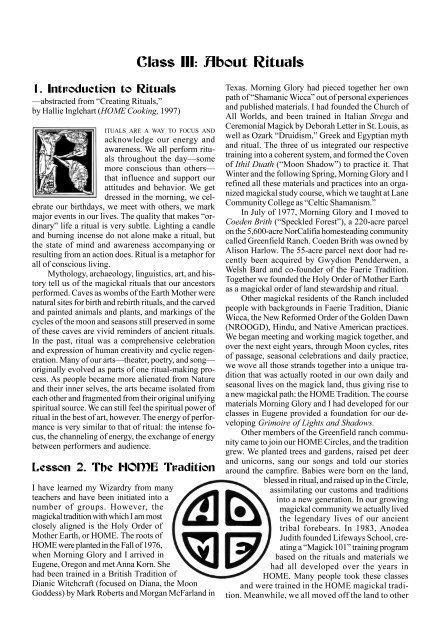Grimoire for the Apprentice Wizard
Create successful ePaper yourself
Turn your PDF publications into a flip-book with our unique Google optimized e-Paper software.
Course Four: Rites 165<br />
rinth found on ancient Cretan<br />
coins and in many places<br />
throughout <strong>the</strong> world—<br />
from Spain to Scandinavia,<br />
and from Arizona to Afghanistan.<br />
One example has<br />
been found in a 4,000-yearold<br />
Neolithic grave in<br />
Sardinia. This one is <strong>the</strong> easiest<br />
to lay out without sophisticated measuring equipment.<br />
I have created several on-<strong>the</strong> spot on sandy beaches,<br />
and also mowed <strong>the</strong>m into long grass in fields.<br />
The archetypal seven-ring labyrinth design prevailed<br />
throughout <strong>the</strong> world <strong>for</strong> millennia. Its immediate<br />
successor, <strong>the</strong> Roman<br />
mosaic labyrinth, has<br />
survived into modern<br />
times as a wide border<br />
framing a central picture,<br />
usually of Theseus slaying<br />
<strong>the</strong> Minotaur. The ninering<br />
path of <strong>the</strong> square Roman<br />
design methodically<br />
fills one quarter be<strong>for</strong>e<br />
progressing to <strong>the</strong> next,<br />
Roman Labyrinth<br />
where <strong>the</strong> pattern is repeated.<br />
A great breakthrough came in <strong>the</strong> development<br />
of <strong>the</strong> Medieval labyrinth design. This had eleven rings<br />
and <strong>the</strong> paths ranged freely through <strong>the</strong> quadrants. In<br />
contrast to <strong>the</strong> square Roman pattern, <strong>the</strong>se were typically<br />
round or octagonal. The<br />
earliest surviving full-sized<br />
example dates from 1235<br />
CE and is set in mosaic<br />
into <strong>the</strong> floor of<br />
Chartres Ca<strong>the</strong>dral in<br />
France. I have visited<br />
this and walked it. This<br />
Chartres design has become<br />
very popular, especially<br />
among New Age<br />
Christians, and it has been reproduced<br />
many places (including<br />
churches) in recent years. Indeed, <strong>the</strong>re are<br />
now entire “Labyrinth Projects” going to help establish<br />
<strong>the</strong>se all over.<br />
A few years ago,<br />
I created a unique new<br />
labyrinth design. The<br />
path (in this case, <strong>the</strong><br />
solid line) winds<br />
around interlaced images<br />
of <strong>the</strong> Goddess<br />
and <strong>the</strong> Hornéd God. I<br />
call it <strong>the</strong> Dearinth,<br />
which means “House of<br />
<strong>the</strong> Gods,” or temple.<br />
Dearinth<br />
Chartres Labyrinth<br />
You can create your own Labyrinth from materials<br />
available anywhere. I recommend a variation on<br />
<strong>the</strong> classic Cretan design that provides <strong>for</strong> a direct<br />
path out from <strong>the</strong> center, so several people can walk<br />
it at once without bumping into each o<strong>the</strong>r on <strong>the</strong><br />
way out. Such a design is called a processional labyrinth.<br />
This pattern can be laid out on <strong>the</strong> ground with<br />
lime, stones, bricks, or even a long chain or rope. It<br />
can be grooved into <strong>the</strong> sand at <strong>the</strong> beach, mowed<br />
into long grass with a lawnmower, or cut out of turned<br />
sod and planted with flowers <strong>for</strong> a more permanent<br />
installation. It can even be marked on a floor with<br />
masking tape or painted onto a large piece of canvas.<br />
All you need to do to mark it out is start in <strong>the</strong> middle,<br />
and use a compass cord to inscribe a series of seven<br />
concentric circle paths, each wide enough to walk<br />
through (also allow room <strong>for</strong> <strong>the</strong> barrier, of course).<br />
Then connect <strong>the</strong> rings with arcs in <strong>the</strong> pattern shown,<br />
to make one continuous looping path.<br />
“Build it, and <strong>the</strong>y will come.” I guarantee you’ll<br />
not only have fun yourself, but folks will come from<br />
all over just to walk your labyrinth!<br />
Resources<br />
<br />
Processional labyrinth<br />
My own statues of Gods and Goddesses and Elemental<br />
wall plaques (including a Dearinth mini-altar)<br />
are available from: www.MythicImages.com.<br />
Large tapestries printed with Labyrinths and Celtic<br />
designs can be obtained from Ancient Circles:<br />
www.AncientCircles.com/textiles.<br />
All kinds of Labyrinth designs and products—as well<br />
as detailed instructions <strong>for</strong> laying out your own<br />
Labyrinth pattern—are available from Labyrinth<br />
Enterprises at: www.labyrinthproject.com.



